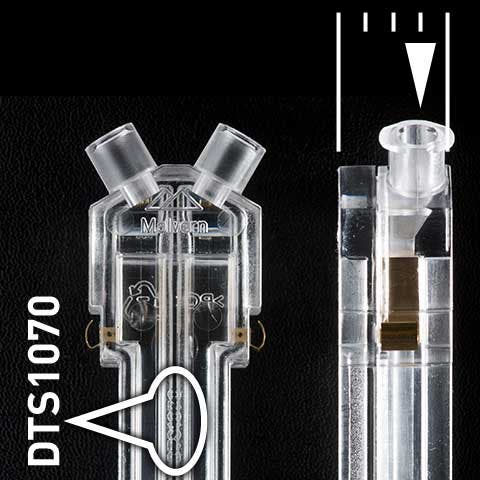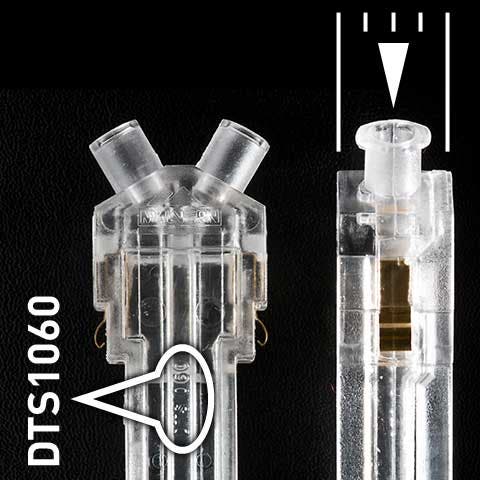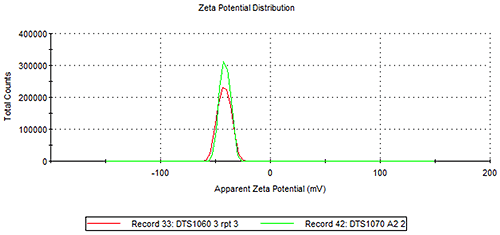The Folded Capillary cell (DTS1070) is a maintenance-free, disposable capillary cell for size and zeta potential measurements in the Zetasizer Nano series of instruments. It is a replacement for DTS1060. It is user-friendly and easy to adapt for the diffusion barrier method to measure from low volumes.
Please login or register for free to read more.
| IMPORTANT: Customers using DTS1070 must first upgrade onto Version 7.02 software or later. If you are unable to upgrade your software please contact your local representative or helpdesk@malvern.com for advice. |
The Folded Capillary cell (DTS1070) is a maintenance-free, disposable capillary cell for size and zeta potential measurements in the Zetasizer Nano series of instruments. It can be used for a single measurement or single series of measurements.
It has been designed so that after a measurement sequence has completed it can be discarded, avoiding any risk of cross contamination. The cell provides a convenient and low-cost alternative to previous reusable quartz capillary cells.
During measurements stoppers are used in the cell sample ports to prevent sample leakage and provide a stable measurement sample within the cell.
The stoppers can be replaced with 'Luer' connectors to provide leak-free connection to the optional MPT-2 Autotitrator and Malvern degasser accessories.
Important sample information can be written on the cell with the enclosed pen to provide identification.
Though primarily designed for zeta measurements the cell can also be utilized for performing sizing measurements.
| Parameter | Setting |
|---|---|
| Minimum sample volume: | 0.75ml |
| Typical applications: | Aqueous and aqueous/alcohol based samples.
Note: The cell is not resistant to organic solvents. CAUTION: The cell is unsuitable for use at high temperatures (above 70°C). |
| CAUTION: It is important to select the correct type of cell in the software to avoid errors in results |
DTS1070 comes packaged in a new box style, with the reference number DTS1070 clearly marked on both the inside and the outside of the box. Each cell is marked with DTS1070, as shown in Figure 1.
To differentiate a DTS1070 from the previous DTS1060 when out of the packaging you should look at the following:
The inlet ports of DTS1070 are slightly offset, whereas the ports for DTS1060 are central. The difference between these can be seen in Figure 1 and Figure 2.
The correct cell must be chosen from within the software (DTS1070 is available in software version 7.02 or later).

|

|
The thermal contact plates have been changed slightly to accommodate some moulding design differences between DTS1070 and DTS1060. The new part number for the thermal contact plates is NVA4037.
When using cells with the Zetasizer Nano series instruments it is important to undertaken certain cleaning and filling procedures.
When filling the cell there are several actions to consider:
Before using a cell for the first time it is recommended that the cell be flushed through with ethanol or methanol to facilitate wetting. A syringe or a wash bottle may be used. Only sufficient fluid to wet the surface of the cell and electrodes is required.
It should then be flushed through with water as described below.
Filling the folded capillary cell is a simple task, though there are a number of precautions to be aware of. Fill the cell as described below:
Note: The stoppers must be fitted before a measurement is performed.
This procedure is also described on the inside of the box.
DTS1070 should be inserted into the Zetasizer Nano with the Malvern logo facing the front of the instrument. In most cases, inserting the cell with the Malvern logo facing backwards will not adversely affect the results, but when the sample scattering is low, the measurement may not be possible if the cell is incorrectly orientated.
The new folded capillary cell, DTS1070 replaces and updates the DTS1060/DTS1061 cells as part of a product improvement programme to ensure that the best results are available at all times.
Extensive work was carried out to ensure that the results for DTS1070 are as good as those for DTS1060. Here we show a comparison between the zeta potential measurement capabilities of both cells.
Three cells were taken at random from each of three different cell production batches:
Note: This test was as a final verification check; significantly more cells were tested during development.
The test sample used for this final verification was the Malvern Zeta Potential transfer standard, DTS1235. A single batch of transfer standard was used; five measurements were made on each cell and then repeated on a fresh aliquot of sample.
| Parameter | Setting | ||
|---|---|---|---|
Material: | Polystyrene Latex (DTS1235) | Cell: | DTS1060 or DTS1070, as appropriate |
Dispersant: | Water | Measurement: | Automatic duration 10 to 100 runs, 5 measurements, 60s delay between measurements |
General options: | Smoluchowski model, dispersant viscosity set as material viscosity | Data processing: | Auto mode |
Temperature: | 25°C, 120s thermal equilibrium time |
A Malvern reference Zetasizer ZS instrument was used throughout the testing.
Figure 3 shows typical results from both DTS1070 and DTS1060. The results are consistent and comparable.

|
The data was also reviewed using the ANOVA technique in the statistics package Minitab 16.
The three sets of data showed the following reproducibility:
Cell | DTS1060 | DTS1070 (development batch) | DTS1070 (first production batch) |
|---|---|---|---|
Mean value ZP (mV) | -41.72 | -41.79 | -41.79 |
The P value for the ANOVA results was 0.99, for this test the hypothesis was that 'there was no significant statistical difference between the measurements made with DTS1060 or DTS1070 cells'. This confirms the hypothesis.
The data confirms that there is no statistical difference between a Zeta Potential measurement made with a DTS1060 cell and that made with a DTS1070 cell.
There is no difference between the results measured on the cells if the correct software set-up is used. If the incorrect cell is chosen within the software, the software will report an incorrect result, as follows:
| Cell used | Software set up as | DTS1235 Transfer standard result will be (nominal value -42mV) |
|---|---|---|
DTS1070 | DTS1060 | Approx. -49mV (-7mV) |
DTS1060 | DTS1070 | Approx -37mV (+5mV) |